#South China Sea Research
Text
Another Survey has come out about how Majority of the Filipinos supposedly support Bong Bong Marcos (BBM) in challenging China over our Disputes in the South China Sea (SCS). Surveys like these are MISLEADING simply because other, BETTER Surveys out there show that the SCS Issue is ALMOST DEAD LAST in the PRIORITIES of the Filipino People
#bong bong marcos bbm#south china sea scs#china#philippines#united states us#octa research#university of the philippines up#malaysia#sabah#pugad island#vietnam#itu aba#taiwan#pulse asia
0 notes
Text
"Discarded shells from restaurants and hotels are being used to restore damaged oyster ecosystems, promote biodiversity and lower pollution in the city’s bays...
Nestled in between the South China Sea and the Pearl River Delta, Hong Kong has been seen historically as an oyster hotspot. “They have been supporting our livelihood since ancient times,” says Anniqa Law Chung-kiu, a project manager at the Nature Conservancy (TNC) in Hong Kong. “Both oysters and their shells are treasures to humans.”
Over the past five decades, however, the city’s sprawling urban development, water pollution, as well as the over-harvesting and frequent seafloor dredging by the lime industry – which uses the crushed shells to make construction material – have destroyed Hong Kong’s oyster habitats and made the waters less hospitable for biodiversity.
The more oyster colonies falter, the worse the problem gets: oysters are filter feeders and purify water by gobbling up impurities. Just one Hong Kong oyster can filter up to 200 litres of water a day, more than any other known oyster species. But decades of rapid industrialisation have largely halted their water-purifying services.
The depletion of Hong Kong’s natural oyster reefs also affects the ability of local farmers to sustainably cultivate their oysters in a healthy environment, denting the reputation of the city’s 700-year oyster farming tradition, designated by Unesco as an “intangible cultural heritage”.
Inhabitants of the coast feel abandoned, says Ken Cheng Wai-kwan, the community leader of Ha Pak Nai on Hong Kong’s Deep Bay, facing the commercial city of Shenzhen in China. “This place is forgotten,” Cheng says. “Oysters have been rooted here for over 400 years. I ask the question: do we want to lose it, or not?”
A group of activists and scientists are taking up the challenge by collecting discarded oyster shells and recycling them to rebuild some of the reefs that have been destroyed and forgotten in the hope the oysters may make a comeback. They’ve selected locations around the island where data they’ve collected suggests ecosystems still have the potential to be rebooted, and there are still enough oyster larvae to recolonise and repopulate reefs. Ideally, this will have a positive effect on local biodiversity as a whole, and farming communities.
Farmers from Ha Pak Nai were among the first to hand over their discarded shells to the TNC team for recycling. Law’s team works with eight oyster farmers from Deep Bay to recycle up to 10 tonnes of shells every year [over 22,000 pounds]. They collect an average of 870kg every week [over 1,900 pounds] from 12 hotels, supermarkets, clubhouses and seafood restaurants in the city, including some of its most fashionable establishments. About 80 tonnes of shells [over 176,000 pounds] have been recycled since the project began in 2020.
Restaurants will soon be further incentivised to recycle the shells when Hong Kong introduces a new fee for waste removal – something that is routine in many countries, but only became law in Hong Kong in July and remains controversial...
Preliminary data shows some of the restored reefs have started to increase the levels of biodiversity, but more research is needed to determine to what extent they are contributing to the filtering of the water, says Law.
Scientists from the City University of Hong Kong are also looking to use oyster shells to increase biodiversity on the city’s concrete seawalls. They hope to provide tiny, wet shelter spots around the seawall in which organisms can find refuge during low tide.
“It’s a form of soft engineering, like a nature-based solution,” says Charlene Lai, a research assistant on the team."
-via The Guardian, December 22, 2023
#oyster#oyster farming#sea shells#seafood#hong kong#ecosystem restoration#biodiversity#ecosystem#water pollution#clean water#cultural heritage#marine life#marine animals#marine science#good news#hope
795 notes
·
View notes
Text

Women warriors in Chinese history - Part 2
(Part 1)
"However, court confessions, unofficial histories, and local gazetteers do reveal a host of women warriors during the Qing dynasty when patriarchal structures were supposedly most influential. Women in marginal groups were apparently not as observant of mainstream societal gender rules. Daughters and wives of “peasant rebels,” that is, autonomous or bandit stockades, were frequently skilled warriors. Miss Cai 蔡†(Ts’ai) of the Nian (Nien) “army,” for example, “fought better than a man, and she was especially fine on horseback. She was always at the front line, fighting fearlessly despite the large number of government troops.” According to a folktale, she managed to rout an invading government force of several thousand with a hundred men and one cannonball after her husband led most of the Nian off to forage for food.
Related to the female bandits were the women pirates among whom Zheng I Sao 鄭一嫂†(literally, Wife of Zheng I; 1775–1844) is the best researched. “A former prostitute … Cheng [Zheng] I Sao could truly be called the real ‘Dragon Lady’ of the South China Sea.” Consolidating her authority swiftly after the death of her husband, “she was able to win so much support that the pirates openly acclaimed her as the one person capable of holding the confederation together. As its leader she demonstrated her ability to take command by issuing orders, planning military campaigns, and proving that there were profits to be made in piracy. When the time came to dismantle the confederation, it was her negotiating skills above all that allowed her followers to cross the bridge from outlawry to officialdom.”
We know slightly more about some of the women warriors involved in sectarian revolts. Folk stories passed down orally are one of the sources. Tales that proliferated in northern Sichuan on the battle exploits of cult rebels of the White Lotus Religion uprising in Sichuan, Hunan, and Shaanxi beginning in the late eighteenth century glorify several women warriors. The tall and beautiful Big Feet Lan (Lan Dazhu 籃大足) and the smart and skillful Big Feet Xie (Xie Dazhu 謝大足) vanquished a stockade together; the young and attractive Woman He 何氏 could kill within a hundred feet by throwing daggers from horseback. The absence of bound feet in Big Feet Lan and Big Feet Xie suggests their backgrounds were either very poor, unconventional, or non-Han.
Sectarian groups accepted female membership readily, and many of these women trained in the martial arts. Qiu Ersao 邱二嫂†(ca. 1822–53), leader of a Heaven and Earth Society (Tiandihui 天地會) uprising in Guangxi, joined the sect because of poverty and perfected herself in the martial arts. Some women came to the sects with skills. Su Sanniang 蘇三娘, rebel leader of another sect of the Heaven and Earth Society, was the daughter of a martial arts instructor. Such sectarian rebel bands are frequently regarded as bandit groups. A history of the Taiping Revolutionary Movement refers to these two cult leaders as female bandit chiefs before they joined the Taipings.
Male leaders of religious rebellions frequently married women from families skilled in acrobatic, martial, and magic arts. These women tended to be both beautiful and charismatic. Wang Lun 王倫, who rebelled in 1774 in Shandong, had an “adopted daughter in name, mistress in fact,” by the name of Wu Sanniang 烏三娘 who was one of Wang’s most powerful warriors. Originally an itinerant performer highly skilled in boxing, tightrope walking, and acrobatics, she terrified the enemy with spellbinding magic. She brought a dozen associates from her old life to the sect, and they all became fearsome warriors known as “female immortals” (xiannü 仙女); three of them, including Wu Sanniang, lived with Wang Lun as “adopted wives” (ifu 義婦). A tall, white-haired woman at least sixty years old, possibly the mother of one of these acrobat-turned women warriors, wielded one sword with ease and two almost as effortlessly. Dressed in yellow astride a horse, hair loose and flying, she was feared as much for her sorcery as for her military skills. Her presence indicates that some of the women came from female-dominated itinerant performing families. Woman Zhang 張氏and Woman Zhao 趙氏, wives of Lin Zhe 林哲, another leader of the cult, were also known for being able to brandish a pair of broadswords on horseback.
Hong Xuanjiao 洪宣嬌†(mid nineteenth century), also known as Queen Xiao (xiaohou 蕭后), wife of the West King of the Taiping Heavenly Kingdom (taiping tianguo 太平天國), was so stunningly beautiful and impressive in swordsmanship that she mesmerized the entire army during battles. The link between early immortality beliefs and shamanism also suggests that these women warrior “immortals” of sectarian cults may represent surviving relics of the female shamans who occupied high positions during high antiquity.
During the White Lotus Religion rebellion in Sichuan, Hunan, and Shaanxi beginning in 1796, five of the generals were at once leaders and wives of other leaders of the cult. They were Woman Qi née Wang (Qiwangshi 齊王氏; Wang Cong’er 王聰兒), Woman Zhang née Wang (Zhangwangshi 張王氏), Woman Xu née Li (Xulishi 徐李氏), Woman Fan née Zhang (Fanzhangshi 范張氏), and Woman Wang 王†née Li 李 (Wanglishi 王李氏). In the Heavenly Principle Religion (tianlijiao 天理教) rebellion that began in Beijing during 1713, the wife of its leader, Li Wencheng 李文成, led three invasions into the city. There was even a “Female Army” (niangzijun 娘子軍) within the Eight Trigrams (baguajiao 八卦教) uprising in Shandong during the Daoguang 道光† reign (1821–51). The female generals, Cheng Sijie 程四姐†and Yang Wujie 楊五姐, were particularly impressive when they wove among enemy forces in the style of “butterflies flitting among flowers,” wielding broadswords on horseback, their hairpins glittering in the light.
A number of female rebel leaders used religion and magic to buttress their power. Many claimed to be celestials and were leaders of sectarian cults (...). Chen Shuozhen 陳碩貞†(?–653) mobilized a peasants’ uprising by declaring that she had ascended to heaven and become an immortal. Tang Sai’er (ca.1403–20), a head of the White Lotus Religion (bailianjiao 白蓮教), designated herself as a “Buddhist Mother” (fuomu 佛母). The spellbinding old woman warrior in Wang Lun’s Clear Water Religion (qingshuijiao 清水教) sect was known to the rebel community as a reincarnation of the highest White Lotus deity, the Eternal Venerable Mother (wusheng laomu 無生老母). Wang Lun relied on her for performing magic and the rituals for calling on their supreme deity. Woman Wang née Liu (wangliushi 王劉氏), one of the numerous female leaders of the White Lotus Religion revolt, also titled herself the Eternal Venerable Mother. Wang Cong’er (1777–98), originally an itinerant entertainer, became the commander in chief of the rebel army she launched with her husband, a master in the White Lotus Religion.
Indeed, itinerant performers such as Wu Sanniang mentioned above were frequently trained in the martial arts since childhood and must have been skilled at performing magic tricks as well. Lin Hei’er 林黑兒†(?–1900), leader of Red Lanterns (hongdengzhao 紅燈照), the young women’s branch of the Boxer’s Movement (yihetuan 義和團), was also originally an itinerant entertainer (her husband was a boatman). Designating herself the Holy Mother of the Yellow Lotus (huanglian shengmu 黃蓮聖母), she taught her followers the skills of wielding swords and waving fans as well as magic to defeat their enemies. Wang Nangxian 王囊仙†(literally, Goddess Nang, 1778–97), an ethnic minority of the Miao tribe, was worshipped as a goddess by her tribesmen before she led them in revolt against the Chinese government."
Chinese shadow theatre: history, popular religion, and women warriors, Fan Pen Li Chen
#history#women in history#women warriors#warriors#warrior women#china#chinese history#asian history#historyblr#qing dynasty#19 century#18th century#Wang Cong’er#hong xuanjiao#su sanniang#qiu ersao#tang sai'er#asia#Zheng Yi Sao
177 notes
·
View notes
Text
Located 62km north-east of the capital Manila, Daraitan village in Rizal province is home to about 5,700 residents, a majority of whom are members of the Dumagat-Remontado indigenous people who consider vast hectares of the mountain range as part of their ancestral domain.
But the village may soon disappear under the same waters that give it life, once the Philippine government finishes building the Kaliwa Dam – one of 16 flagship infrastructure projects of former president Rodrigo Duterte that is being funded by China.
The new dam is expected to provide Metro Manila with an additional 600 million litres of water daily once it is finished by end-2026. Officials said building the 60m-high reservoir is even more necessary now that the country is starting to feel the impact of the El Nino weather phenomenon.
But it was only in 2021 under Mr Duterte that construction finally broke ground, three years after Manila and Beijing signed the 12 billion peso (S$288 million) loan agreement.
Of the 119 on the list [of flagship projects of the "Build, Build, Build” infrastructure programme], Mr Duterte turned to China to finance 16 big-ticket projects in a bid to cement his legacy by the time his presidency ended in 2022. He embraced Beijing during his term and even downplayed Manila’s claims in the disputed South China Sea in favour of securing loans and grants from China.
Analysts have criticised Mr Duterte’s infrastructure programme as ambitious. Perennial domestic issues like local politics, right-of-way acquisition problems, lack of technology and red tape in bureaucracy led to severe delays in the projects.
The same issues hound the China-funded projects – which come under Beijing’s Belt and Road Initiative (BRI) to build infrastructure in developing nations – with the problems made more severe by Beijing’s high interest rates in its loan agreements and local backlash due to displacement of residents or potential environmental damage.
Critics say the BRI has been detrimental in the long run to some recipient countries, especially those that have been unable to repay their loans, like Sri Lanka and Zambia.
The Duterte government’s failure to take advantage of its BRI loans was a “missed opportunity” for the Philippines, said infrastructure governance specialist Jerik Cruz, a graduate research fellow at the Massachusetts Institute of Technology.
The four completed China-funded projects under Mr Duterte were controversial too. But they came to fruition because they had the support of local politicians allied with Mr Duterte and therefore increased his political capital, said Dr Camba.
Tribal leaders said they were not properly consulted regarding the project that threatens their traditional way of life. Environmentalists from the Stop Kaliwa Dam Network also say the project would destroy 126 species of flora and fauna in the Sierra Madre.
The Philippines’ Indigenous Peoples’ Rights Act states that the government must first secure a tribe’s free, prior and informed consent before building on its ancestral lands.
But Ms Clara Dullas, one of the leaders of the Dumagat-Remontado in Rizal, alleged that the Duterte government had either misinformed or pressured other tribe members into giving their consent.
She could not bear to hold grudges, though, noting that the Dumagat-Remontado organisations that eventually agreed to the Kaliwa Dam were each given 80 million pesos, or $1.9 million, in “disturbance” fees.
“The Kaliwa Dam is the reason why our tribe is divided now. There is a crack in our relationships even if we all come from the same family,” said Ms Dullas. “I can’t blame the others because we lack money. I believe there was bribery involved.”
The government requires them to present identification documents, and only those given passes may enter. Mr Dizon said this is to ensure that no unidentified personnel enter the area [close to the construction zone].
“We feel like we are foreigners in our own home because the Chinese and the people in our own government are now preventing us from entering the lands where we grew up,” said tribe leader Renato Ibanez, 48.
Mr Ibanez also accuses the Philippine authorities of harassing tribe members who are vocal against Kaliwa Dam. Some of them have been accused of working with communist rebels, a charge the tribe vehemently denies.
Unlike his predecessor, Mr Marcos is more aggressive in defending Manila’s overlapping claims with Beijing in the South China Sea, but still fosters economic ties with it.
Geopolitical tensions between the two nations and Mr Marcos’ stance towards Beijing are going to dictate the fate of the pending China-funded projects the President inherited from Mr Duterte, said Mr Cruz.
Tribe members said they would be more amenable if Mr Marcos would revisit Japan’s proposed Kaliwa Intake Weir project that Mr Duterte had set aside.
“We like Japan’s proposal. It would not destroy our forests. It would not affect residents here. The Philippines would not be buried in debt,” said Ms Dullas.
This was among the alternatives the Dumagat-Remontados offered during their nine-day march in February 2023, when some 300 members walked 150km from Quezon and Rizal all the way to Manila to protest against the Kaliwa Dam.
But they failed to secure an audience with Mr Marcos. They remain wary of the President’s position on the Kaliwa Dam and other controversial China-funded deals.
“As much as we want to fully pin our hopes on him, we don’t. We’ve learnt from past efforts to trick us, make us believe a project is about to end, only for it to be resurrected again years later,” said Ms Dullas.
2024 Mar. 3
#philippines#indigenous rights#dumagat-remontado#state violence#red tagging#infrastructure#environmental issues#afp-pnp
53 notes
·
View notes
Photo

500-Year-Old Shipwrecks With Porcelain and Wood Discovered in South China Sea
Hundreds of years ago, the Ming dynasty relied on maritime trade to import key goods from foreign countries.
Now, the discovery of two Ming-era shipwrecks in the South China Sea is giving experts a better idea at what that trade looked like.
The shipwrecks were discovered about 1 mile below sea level on the northwest slope of the South China Sea, according to a May 22 news release from the State Administration of Cultural Heritage via the Institute of Archaeology at the Chinese Academy of Social Sciences.
Here’s what archaeologists have found in the shipwrecks so far.
A TROVE OF PORCELAIN
Experts determined that the first shipwreck dates to the Zhengde period of the Ming dynasty — which lasted from 1506 until 1521.
The wreck was overflowing with porcelain goods, including bowls, cups, plates and jars in various glaze colors, officials said.
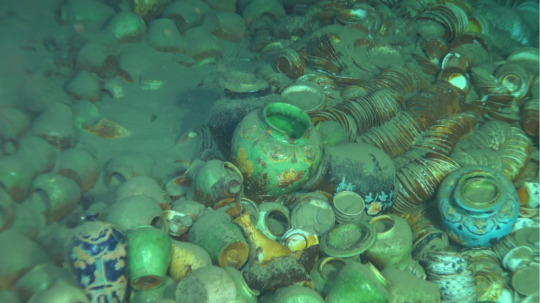
More than 100,000 relics, mostly made of porcelain, have been uncovered so far, and experts said they are spread across hundreds of thousands of square feet.
Photos from the discovery show stacks of porcelain pottery. Although most of the pieces are covered with sand and dirt, ornate, colorful patterns are still visible beneath the grime.
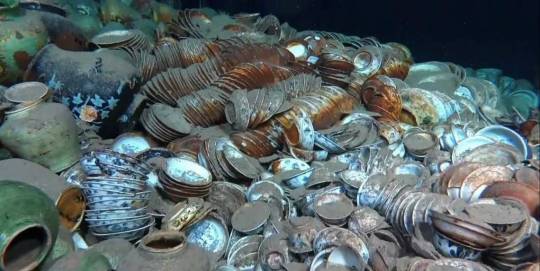
STACKS OF LOGS AND POTTERY
The second, older shipwreck dated to the Hongzhi period of the Ming dynasty — which lasted from 1488 until 1505.

At this site, experts found stacks of logs and some pottery, according to officials. The persimmon logs were all a similar size and were neatly stacked.

Further research revealed that the logs could have been intended for shipbuilding, experts said. Chinese literature indicates that most products used to build ships were imported from foreign countries, according to the release.
A UNIQUE DISCOVERY
Archaeologists said their discovery marks the first time ancient ships sailing and returning have been found in the same area, indicating that they were likely on an important trade route.
Experts will continue researching and monitoring the wrecks, and they hope to learn more about ancient maritime trade routes and cultural exchanges, they said.
By Moira Ritter.

#500-Year-Old Shipwrecks With Porcelain and Wood Discovered in South China Sea#ming dynasty#Ming-era shipwrecks#ancient artifacts#archeology#archeolgst#history#history news#ancient history#ancient culture#ancient civilizations#ancient china#chinese history#chinese art
188 notes
·
View notes
Text
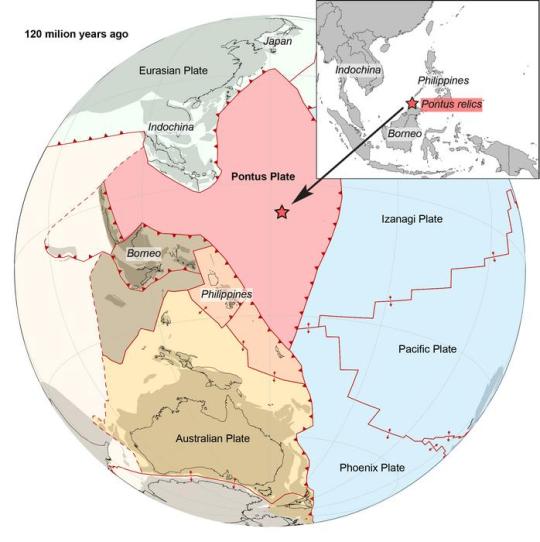
Plate tectonic surprise: Utrecht geologist unexpectedly finds remnants of a lost mega-plate
Utrecht University geologist Suzanna van de Lagemaat has reconstructed a massive and previously unknown tectonic plate that was once one-quarter the size of the Pacific Ocean. Her colleagues in Utrecht had predicted its existence over 10 years ago based on fragments of old tectonic plates found deep in the Earth’s mantle. Van de Lagemaat reconstructed lost plates through field research and detailed investigations of the mountain belts of Japan, Borneo, the Philippines, New Guinea, and New Zealand. To her surprise, she found that oceanic remnants on northern Borneo must have belonged to the long-suspected plate, which scientists have named Pontus. She has now reconstructed the entire plate in its full glory. Suzanna van de Lagemaat will defend her dissertation on this plate tectonics puzzle at Utrecht University on Friday, October 13.
Understanding the movements of the tectonic plates that make up the earth’s rigid outer shell is essential to understand the planet’s geological history. The movements of these plates strongly influenced how the planet’s paleogeography and climate have changed over time, and even where to find rare metals. But large oceanic plates from the geological past have since disappeared into the earth’s mantle by means of subduction. They have left behind only fragments of rock hidden in mountain belts. Van de Lagemaat studied the planet’s most complicated plate tectonic region: the area around the Philippines. “The Philippines is located at a complex junction of different plate systems. The region almost entirely consists of oceanic crust, but some pieces are raised above sea level, and show rocks of very different ages.”
Reconstruction
Using geological data, Van de Lagemaat first reconstructed the movements of the current plates in the region between Japan and New Zealand. That revealed how large the area was of plates that must have disappeared in the current western Pacific region. “We also conducted field work on northern Borneo, where we found the most important piece of the puzzle. We thought we were dealing with relicts of a lost plate that we already knew about. But our magnetic lab research on those rocks indicated that our finds were originally from much farther north, and had to be remnants of a different, previously unknown plate.” But the important realisation was yet to come. “11 years ago, we thought that the remnants of Pontus might lie in northern Japan, but we’d since refuted that theory”, explains Douwe van Hinsbergen, Van de Lagemaat’s PhD supervisor. “It was only after Suzanna had systematically reconstructed half of the ‘Ring of Fire’ mountain belts from Japan, through New Guinea, to New Zealand that the proposed Pontus plate revealed itself, and it included the rocks we studied on Borneo.”
Relics
The relics of Pontus are not only located on northern Borneo, but also on Palawan, an island in the Western Philippines, and in the South China Sea. Van de Lagemaat’s research also showed that a single coherent plate tectonic system stretched from southern Japan to New Zealand, and it must have existed for at least 150 million years. That is also a new discovery in the field.
Waves
The previous predictions of the existence of Pontus were made possible because a subducted plate leaves behind traces when it ‘sinks’ into the earth’s mantle: zones in the mantle with anomalous temperatures or compositions. These anomalies can be observed when seismographs pick up signals from earthquakes. Earthquakes send waves through Earth’s interior, and when they travel through an anomaly, such as a fragment from an old plate, the anomaly produces a disruption of the signal. Geologists can trace these disruptions to the existence of phenomena in the mantle, such as fragments of tectonic plates. That allows them to look 300 million years into the past; older plate fragments have ‘dissolved’ at the boundary between the mantle and the core. The study from 11 years ago showed that a large subduction zone must have run through the western paleo-Pacific Ocean, which separated the known Pacific plates in the east from the hypothetical Pontus plate in the west. This hypothesis has now been independently demonstrated by Van de Lagemaat’s research.
IMAGE....The Pontus oceanic plate that was reconstructed by Suzanna van de Lagemaat: its location in the paleo-Pacific ocean 120 million years ago, and its present relicts. An earlier study showed that a large subduction zone must have run through the western paleo-Pacific Ocean, which separated the known Pacific plates in the east from a hypothetical Pontus plate in the west. This hypothesis has now been independently demonstrated by Van de Lagemaat’s research. CREDIT Suzanna van de Lagemaat, Utrecht University
95 notes
·
View notes
Text


The covers of the new edition of T.P. Bon being released next month are just so, so, so cute; I love the colors and the simple design and of course I love the characters, particularly vol 2 with Ream and Buyoyon in pink. Normally I'd just pick them up along with other things I'm getting from Japan, but they're also promising ANOTHER deluxe edition release in July so I won't be able to decide which edition to pick up until then =_= I haven't even gotten my hands on the sf short stories deluxe editions yet, all ten volumes are on a ship somewhere in the South China Sea probably.
Bon is getting a Netflix anime treatment sometime this year (hence the new manga releases). It's a sci-fi series about teen time travel agents saving the lives of ordinary people throughout history. I don't normally watch anime but I'll probably check it out; if it's anything like the manga it'll be a solid series with really good historical research, fun time travel shenanigans, and a lot of moral quandaries about human lives. Maybe if this does well for Netflix they'll do Mojako next...
youtube
#t. p. bon#tp bon#fujiko f fujio#of fujiko's major shonen sf series which is to say bon + 21emon + mojako#mojako is my favorite#but bon might be the one i've read the most times#and remember the best#it has distinct historical settings in each chapter and clear story structures and it's just well-paced and well-written honestly!#also it has these awful truly awful depictions of historical atrocities like witch hunts...#and also some socially conscious stories about american slaves and whale hunting and the crusades
32 notes
·
View notes
Text
this is really weak of me but I really do have to headcanon the Nations as having nothing to do with their governments and at times actively working against them because otherwise the atrocities are Not Fictional...
and anyway these beings hundreds of years old absolutely know that governments do not always have the people's best interests in mind. Do not always take care of the land. Nations believe their role is to take care of their land and their people, and maybe the older Nations tried to work with those in power in the beginning, but quickly learn their lesson.
because of this headcanon, I imagine the Nations all have 'departments' they belong to that focus on a certain issue. It would be impossible to have one individual try to have intimate knowledge of every single issue a country faces, and I love the implications this has on how much the Nations rely on each other, and how much their relationships are not reflective of human politics, because their purpose is not to reflect their people but to protect them and the land they're on.
SO finally, to the point of this post.
Here's what I think certain Nations do:
England and Russia are in charge of information gathering AKA espionage, as both have infiltrated their own governments at a very high level. Arthur is in MI6, Ivan is in the KGB-turned-FSK-turned-FSB. They're valuable assets to the rest of the world because they tend to have information on what everyone's governments are doing. Some other Nations who work in this department are Hungary, Philippines (F), Canada, Cuba, Ukraine, Scotland, Wales, Northern Ireland.
A lot of Nations work on environmental issues - Sweden, Finland and Denmark focus on governance as a way to mitigate environmental issues, while Australia, New Zealand, South Africa are focused on conservation, Brazil, Colombia, Congo focus on deforestation and air pollution, the Pacific Islands on rising sea levels and ocean pollution.
China, France, Ireland and Turkey are focused on food security - each one focuses on a specific aspect of it. China on availability, Ireland on access, France on utilisation and Turkey on stability.
Social welfare is headed by Austria and Belgium, with Spain, the Italies, Greece and Portugal focused on it.
Internal security is handled by the Germany brothers and Switzerland - this is the protection of the Nations themselves. Arranging identities, extraction of Nations who land themselves in trouble, and also the keeper of their arsenal.
America heads the research and development department that connects everything together - they develop the gadgets used by Arthur and Ivan's team, help develop technologies and conduct research focused on the environment and food security, help trial new ideas on addressing poverty, hack databases in order to help create identities for Nations. This department includes Japan, South Korea, India (F), Taiwan, Tony (not a Nation but heavily involved), Liechtenstein, Hong Kong, Belarus, Netherlands, Estonia, Mexico (F).
EDIT: I have to re-think a lot of this because I keep thinking about how very little countries there are compared to shit happening in the world and it messes with this universe a little bit. SO. WILL BE RE-WORKED.
#hetalia#aph#hetalia world series#hetalia world stars#hws england#hws america#aph america#aph england#too many people to tag#i think theres a lot of like TOPICS im missing that are relevant to nations#but its 1am this is the ones i thought of#the people i chose for each department are a mix of like#canons headcanons vague stats#also when i have an (f) next to someones name it means i headcanon them as ladies despite himaruya having them as men#✎#m: hetalia#hetalia: headcanon (au)#hetalia au: no government
43 notes
·
View notes
Text
Rare footage obtained by BBC Korean shows North Korea publicly sentencing two teenage boys to 12 years of hard labour for watching K-dramas.
The footage, which appears to have been filmed in 2022, shows two 16-year-old boys handcuffed in front of hundreds of students at an outdoor stadium.
It also shows uniformed officers reprimanding the boys for not "deeply reflecting on their mistakes".
South Korean entertainment, including TV, is banned in the North.
Despite that, some are prepared to risk severe punishment to access K-dramas, which have a huge global audience.
Footage such as this is rare, because North Korea forbids photos, videos and other evidence of life in the country from being leaked to the outside world.
This video was provided to the BBC by the South and North Development (Sand), a research institute that works with defectors from the North.
It suggests authorities are coming down harder on such incidents. The clip has reportedly been distributed in North Korea for ideology education and to warn citizens not to watch "decadent recordings".
The video includes a narrator who is repeating state propaganda. "The rotten puppet regime's culture has spread even to teenagers," says the voice, in an apparent reference to South Korea. "They are just 16 years old, but they ruined their own future," it adds.
The boys were also named by officers and had their addresses revealed.
In the past, minors who broke the law in this way would be sent to youth labour camps rather than put behind bars, and the punishment was usually less than five years.
North Koreans tell of neighbours starving to death
A family's escape from North Korea through a minefield and stormy seas
In 2020, however, Pyongyang enacted a law to make watching or distributing South Korean entertainment punishable by death.
A defector previously told the BBC that he was forced to watch a 22-year-old man shot to death. He said the man was accused of listening to South Korean music and had shared films from the South with his friend.
Sand CEO Choi Kyong-hui said Pyongyang sees the spread of K-dramas and K-pop as a danger to its ideology.
"Admiration for South Korean society can soon lead to a weakening of the system... This goes against the monolithic ideology that makes North Koreans revere the Kim family," she said.
North Koreans started getting a taste of South Korean entertainment in the 2000s, during the years of the South's "sunshine policy" which saw it offering unconditional economic and humanitarian aid to the North.
Seoul ended the policy in 2010, saying it found the aid did not reach the ordinary North Koreans it was intended for, and that it had not resulted in any "positive changes" to Pyongyang's behaviour.
But South Korean entertainment continued to reach North Korea through China.
"If you get caught watching an American drama, you can get away with a bribe, but if you watch a Korean drama, you get shot," a North Korean defector told BBC Korean on Thursday.
"For North Korean people, Korean dramas are a 'drug' that helps them forget their difficult reality," the defector said.
"In North Korea, we learn that South Korea lives much worse than us, but when you watch South Korean dramas, it's a completely different world. It seems like the North Korean authorities are wary of that," said another North Korean defector in her 20s.
Additional reporting by Kelly Ng in Singapore
28 notes
·
View notes
Text
soooo ummmm i was designing and researching for the lmk dragon heirs and i have gone down a very interesting rabbit hole;
i was looking for the north and west seas on a map of china and i could not see it, im in ap world rn and remembered that china had a lot more land bfore than it does now so i take that into consideration
the north sea is lake baikal, in present day siberia. it is the largest freshwater lake in asia and (in terms of volume) it is the deepest freshwater lake in the world.
the west sea is the saline lake qinghai
the south sea is the south Chinese sea and the east sea is the east Chinese sea, pretty simple
and here is where i get weird, i now know a lot more information about marine biology than i did before reseaching for a fucking LEGO monkie kid OC
did you know that there are no native bioluminescence organisma native to fresh water habitats? cuz i do
did you know that ao shun, the black dragon king of the north, was associated with winter and deep depths because his domain (lake baikal) was deep as FUCK and froze over during the cold months? cuz i do
what the fuck am i even looking for??? when am i gonna use this information??
why do i know so much about how the environment of lake baikal affects the body colors of its native amphipods???? this was meant to be for a fucking LMK oc
lets not even GET INTO the HOURS apon HOURS i spent researching basic mandarin grammar and chinese surname culture
i know so fucking much about chinese weaponry, specifically Jian and Dao blades, and chinese traditional dress. and the fucking chinese dragon kings
and for what?????? when am i fucking going to use this??? i really do not know; it was fun to find out tho
#lego monkie kid#autism#lmk#monkie kid#PLEASE tell me im not the only one who does this#my stuff#lmk oc#lego monkie kid oc#IM NOT EVEN FUCKING DONE
43 notes
·
View notes
Text
Dubois' bibliography: Fairy books (1)
I talked a LOT before of Pierre Dubois, his famous "Fairy/Elf/Lutin Encyclopedias", his collections of fairytales, and so forth and so on. And yes we have to agree that he has a very free, inventive, poetic style when it comes to retelling the various myths and legends surrounding the fair folk and other supernatural beings. As such, while his books are very entertaining and very beautiful, they are not to be used as a serious research material and can be quite misleading between Dubois' personal inventions, crafted genealogies and fictional history of "Elfland"...
BUT the wonderful and very pleasant thing with Dubois is that at the end of each of his Encylopedias he leaves us with a complete bibliography of all the books he used when writing them. I have rarely stumbled upon such complete bibliographies about the "fair folk", "good neighbor", petit peuple" and so forth, and while it goes a bit beyond what this blog is about (fairy tales proper), I still thought of sharing some of it here because my Dubois posts were all here.
Now, I can't share the entirety of the bibliography because it would be too big. However what I will share is all the books Dubois placed in his bibliography... in English. Indeed, Dubois reads the English and as such a good chunk of his bibliography is English-speaking (there are also some Spanish, Italian and German books in his lists). As such, if you are an English speaker you can easily go check these texts. (Note, this comes from his bibliography of his "Encyclopedia of Fairies", so that we stay within the "fairy tale" theme of this blog)
Tolkien's On Fairy-Stories
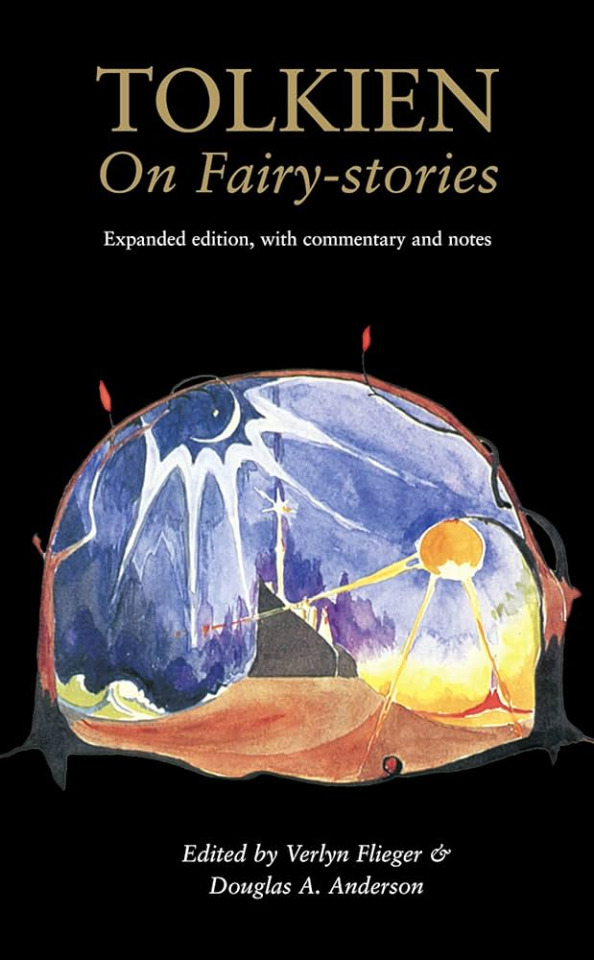
Beatrice Phillports, Mermaids

Richard Carrington, Mermaids and Mastodons

Gwen Benwell and Arthur Waugh, Sea Enchantress

The Lost Gods of England, Brian Branston

Wilfrid Bonser, A bibliography of folklore

Masaharu Anesaki, Japanese Mythology (also known as the History of Japanese Religion)

F. J. Child, The English and Scottish Popular Ballads

Moncure Daniel Conway, Demonology and Devil Lore

T. C. Croker, Fairy Legends and Traditions of the South of Ireland

N. Belfield Dennys, The Folklore of China [The book has the very unfortunate subtitles "and its affinities with that the Aryan and Semitic races", but it was written in the 19th century so...)

David Crockett Graham, Songs and Stories of the Ch'uan Miao

Thomas Keightley, The Fairy Mythology

P. Kennedy, Legendary Fictions of the Irish Celts

John Rhys, Celtic Folklore: Welsh and Manx

Sir George Webb Dasent's translation of Popular Tales from the Norse

The Norse Myths (as rewriten by Crossley)

Delaporte Press' Great Swedish Fairy Tales, illustrated by John Bauer

Inger and Edgar Parn d'Aulaire, D'Aulaire's Trolls (also known as D'Aulaire's Book of Trolls)


The Florence Ekstrand edition of Theodore Kittelsen's Norvegian Trolls and Other Tales

G. Fox, The Archaeology of the Cambridge Region

Edward L. Gardner, Fairies

M. Geoffrey Hodson, The Kingdom of the Gods

Sir Arthur Conan Doyle, The Coming of the Fairies

Walter Burkert, Ancient Mystery Cults

Sabine Baring-Gould, Curious Myths of the Middle Age

#pierre dubois#bibliography#book list#resources#fairy tales#fairytales#book resources#mythology#folklore#folklores#fairies#fairy#fairy book#mermaids
12 notes
·
View notes
Text
"Around the world, mangrove forests have undergone a decades-long decline that is just now slowing to a halt.
In Pakistan, by contrast, mangroves expanded nearly threefold between 1986 and 2020, according to a 2022 analysis of satellite data.
Experts attribute this success to massive mangrove planting and conservation, as well as concerted community engagement.
Many in Pakistan are looking to mangroves to bolster precious fish stocks and defend against the mounting effects of climate change — even as threats to mangroves, such as wood harvesting and camel grazing, continue with no end in sight."
"His sandaled feet drenched in black mud, Rashid Rasheed points to one of the mangrove nurseries he’s been looking after for the past few years. With wooden walls topped by green netting, a dozen nurseries shelter thousands of saplings.
Rasheed, a researcher and nursery expert with the government of Balochistan province in Pakistan, has been leading a drive to establish nurseries in the coastal town of Dam. The goal is to expand and enhance the town’s scattered patches of natural mangrove forest, which have shriveled due to human activities.
“These nurseries have 50,000 saplings that are ready to be transported to the creeks for planting” Rasheed tells Mongabay.
Rasheed’s work is part of a five-year project initiated in 2019 by the Chinese Academy of Sciences’ South China Sea Institute of Oceanography that has planted mangroves on 16 hectares (40 acres) at Dam, and at other sites in Balochistan and neighboring Sindh province.
It’s one of many projects aiming to restore Pakistan’s mangroves. These semiaquatic trees offer a host of benefits, such as protecting coasts against storms and rising sea levels, providing habitat for fish, birds, and other wildlife, sequestering carbon better than most other ecosystems on Earth, and sustaining the livelihoods of some 120 million people globally, according to the IUCN.
Around the world, mangrove forests have undergone a decades-long decline that’s just now slowing to a halt. But Pakistan bucks this trend. The country’s mangroves expanded from 48,331 hectares in 1986 to 143,930 hectares in 2020 (119,430 to 355,659 acres), a nearly threefold increase, according to a 2022 analysis of satellite data. “It is because of the constant endeavor by government and NGOs,” the analysis states, citing restoration, research, and awareness-raising campaigns “now being religiously carried out to conserve and regrow mangroves” by local, national and foreign bodies. Fishing communities, who depend on mangroves for fuel, shelter and as fish nurseries, are often key to the success of Pakistan’s mangrove restoration, providing the labor for planting and protection."
-via Mongabay, February 5, 2024
#pakistan#mangrove#forest#ecosystem#reforestation#carbon emissions#climate change#climate crisis#climate action#fishing#community engagement#good news#hope
359 notes
·
View notes
Text

IMAGES: USAF F-35 jets are the first 5ª generation fighters to land on the ally Brunei
Fernando Valduga By Fernando Valduga 05/03/2024 - 23:55in Military
The U.S. Air Force (USAF) F-35A fighters paid a visit to Brunei on March 1º, the first time that fifth-generation stealth jets landed in the small Pacific island nation.

Two F-35s made the journey from Eielson Air Base, Alaska, to Rimba Air Base, Brunei, a visit that coincided with a diplomatic visit by the Deputy Deputy Secretary of Defense for Indo-Pacific Security Affairs, Jedidiah Royal. The trip was also made by Major General Mark Weber, assistant to the National Air Guard of the PACAF commander.


Members of the Royal Air Force of Brunei, including Commander Brig. General Dato Sharif saw the aircraft, which was on static display, and asked the USAF aviators questions. The aircraft left for its return flight on March 2.
The F-35 visit took place 40 years after the U.S. officially recognized Brunei, after its independence from the United Kingdom, which took control after World War II, when the nation was occupied by Japanese imperial forces. The visit takes place at a time when the United States intends to strengthen cooperation with a wide range of allies in the Indo-Pacific.

Brunei and the U.S. signed a memorandum of understanding on defense cooperation in 1994 and have been conducting joint exercises regularly since then. The air forces of the two countries worked together in September 2023 as part of exercise Pacific Angel 23-3, focused on humanitarian assistance and humanitarian aid in disasters. As part of this exercise, the U.S. Air Force unfolded an HC130-J Combat King II, an HH-60G Pave Hawk and a C-17 Globemaster III to Brunei.

— PACAF (@PACAF) March 4, 2024
In December 2023, the U.S. Indo-Pacific Command received Brunei officials for bilateral talks that included the signing of a "Section 505 agreement," a prerequisite for the granting of military training or equipment to a foreign nation.

Although it has only 5,765 square kilometers - a little smaller than the state of Delaware in the USA - Brunei claims a slice of the South China Sea that is less than 1,600 kilometers from China. As China is its largest trading partner and foreign investor, according to the U.S. Peace Institute, Brunei has sought to "protect" its dependence on China by building a stronger relationship with the U.S., wrote researcher Sufrizul Husseini.

However, in the growing competition of great powers between the two, the U.S. wants to build ties with countries throughout the region and has used the visits of USAF fighters and bombers as one of the ways to demonstrate its commitment to the allies.
Just a year ago, for example, the U.S. Air Force F-22s were sent to the Philippines, becoming the first fifth-generation fighters in that country. In April, two B-1B Lancers bombers participated for the first time in an exercise with the Indian Air Force. And in June, a B-52 landed in Indonesia, another novelty. And in October, a B-52 landed in South Korea, the first landing of its kind in more than 30 years.

These strategic visits send a message about security cooperation and partnership aimed at deterring China from risking a broader conflict through expansion into neighboring territories.
Photos: USAF / Tech. Sgt. Eric Summers Jr.
Tags: Military AviationF-35 Lightning IIUSAF - United States Air Force / U.S. Air ForceWar Zones - Indo-Asia-Pacific
Sharing
tweet
Fernando Valduga
Fernando Valduga
Aviation photographer and pilot since 1992, he has participated in several events and air operations, such as Cruzex, AirVenture, Dayton Airshow and FIDAE. He has works published in specialized aviation magazines in Brazil and abroad. He uses Canon equipment during his photographic work in the world of aviation.
Related news
MILITARY
Impressive images show aurora borealis above the aircraft carrier HMS Prince of Wales from the United Kingdom
05/03/2024 - 21:39
BRAZILIAN AIR FORCE
VIDEO: FAB's first Gripen flies with modified wings
05/03/2024 - 19:59
ARMAMENTS
Turkey conducts successful tests of new Aselsan glider bombs
05/03/2024 - 16:00
MILITARY
Portuguese Air Force received its second P-3C Orion plane
05/03/2024 - 13:00
HELICOPTERS
Qatar Air Force reaches the mark of 2,500 flight hours in the NH90 helicopter fleet
05/03/2024 - 11:00
MILITARY
Latvian Air Base becomes NATO's third Air Police base in the Baltic Sea region
05/03/2024 - 09:00
5 notes
·
View notes
Text
South Korea Is A Test Case On How To Fight An Ecological Disaster
After Two-thirds of the Country’s Tidal Flats Were Lost to Shoreline Development, South Korean Scientists Set Out to Prove Why This Ecosystem is so Essential.
— By Anna Jeanine Kim | Photographs: By Youngrea Kim | August 15, 2023

The sun sets over a tidal flat in Southwestern South Korea. Tidal Flats are a type of Ecosystem that Provide Habitat for Wildlife and help fight climate change—yet many are at risk of disappearing.
Yubudo, South Korea — As Byeongwoo Lee slowly walks across a sandy tidal flat on Yubudo, a small island off the west coast of South Korea, the birding guide does so quietly.
“You can’t see the birds right now,” Lee said. “You can feel them.”
Through the scope, it was just possible to make out their blurry shapes in the dark, and to hear the gentle but powerful “whhhrrr-reet-reet-reet” of tens of thousands of birds as they fed at the shoreline and in the shallow water.
As the sun rose, the tide retreated until it revealed six miles of the muddy sea floor. Channels of water like tree branches crisscrossed mud teeming with crabs, clams, snails, and sea worms.

Top: Depending on the time of day, tidal flats are either completely submerged under water or exposed to the air. Seen here at low tide, tidal channels criss cross an exposed tidal flat neighboring a residential neighborhood in Muan, South Korea.
Bottom: During an annual ceremony that takes place on the first full moon of the Lunar New Year, Gwangho Chu bows before a ceremonial table placed on a tidal flat in Wando, a small island in South Korea. Coastal communities in the Yellow Sea region have continued to honor the centuries-old tradition of celebrating the ancestral spirits of the sea and praying for a good harvest from the tidal flats.
Tidal flats like these are a type of wetland found on coastlines around the world. Korea’s Yellow Sea tidal flats, like those found on Yubudo Island, form the heart of an 18,000-mile route traveled by 50 million shorebirds as they migrate from eastern Russia and Alaska in the summer to Australia and New Zealand in the winter.
Many of them only stop once on their marathon journeys, and the tidal flats of South Korea provide them with essential food and shelter.
Yet despite their critical importance to the environment, many are at risk of disappearing. Some of the most important, and most endangered, are found surrounding the Yellow Sea along the shores of China and the western side of the Korean peninsula.
For decades, people have been transforming them into industrial sites and farms, squeezing them into smaller areas and pushing some species to the brink of extinction. But as science increasingly shows how wetlands like these benefit wildlife and help fight climate change, South Korean scientists and conservationists are gaining momentum in their effort to save and restore what’s left.

Top: From left, Okji Kim, Yangim Kim, and Sunim Bae work together to make gamtae-kimchi, a special type of kimchi made with sea algae instead of cabbage. With limited farmland available, coastal communities have traditionally relied on the abundance of tidal flats, developing a unique culinary culture over thousands of years.
Bottom: A seafood meal is served at a restaurant in Yamido, a small island now connected to the mainland by the construction of the 21-mile-long seawall built as part of the Saemangeum development project. Many of the residents living around the seawall used to make a living working in the seafood industry, but the destruction of nearby tidal flats significantly decreased their harvests, threatening their livelihood.
Why Tidal Flats Are An Environmental Powerhouse
“The tidal flats made the relationship between humans and the sea possible,” said Joon Kim, a senior researcher at the Jeonnam Research Institute who studies the culture around Korean tidal flats.
Since prehistory, South Korea’s coastal communities relied on tidal flats for harvesting clams, crabs, octopus, and seaweed, adjusting their way of life to the tide’s schedule. Their biodiversity and abundance inspired many beloved local cuisines, unique coastal culture, and a fishing economy worth over $330 million U.S. dollars a year.
These same ecosystems are now helping fight climate change.
South Korean universities are partnering with the government to study tidal flats and their ability to clean polluted water, protect shoreline communities from storms, and mitigate climate change by absorbing carbon dioxide.
Korean tidal flats are full of tiny one-celled organisms called benthic diatoms that sink through the mud as they complete their life cycle, burying carbon dioxide in the deep sediment, says Jong Seong Khim, a marine scientist and professor at Seoul National University.

Top: Seoul National University researcher Inok Lee hands a sediment sample to her colleague outside the Saemangeum seawall. Scientists like Lee are studying how the large-scale development project is harming water quality and marine wildlife.
Bottom: People ride recreational boats through a man-made canal at a city park in Songdo, South Korea. Once a thriving tidal flat ecosystem, Songdo was built on reclaimed land and hailed for creating "a city out of nothing." Over the past 70 years, South Korea has lost over two-thirds of its tidal flats due to reclamation projects like these.
The diversity and number of benthic diatoms make South Korean tidal flats unique, as does its thick mud—over 80 feet deep in some tidal flats.
In 2021, Khim and his fellow researchers published a study showing South Korea’s tidal flats and salt marshes absorb 260,000 tons of carbon dioxide annually, equivalent to taking about 110,000 cars off the road every year.
The same year, the South Korean government announced a four-year project to bring back tidal flats and salt marshes to help fight climate change.
Kim hopes that by showing how effectively tidal flats store carbon, governments and conservation groups will recognize them as valuable and save them from being destroyed.
Why Tidal Flats Are In Danger
In the past 70 years, South Korea has transformed from a country devastated by war into a highly developed, industrial nation. During this rapid change, two-thirds of its tidal flats subsequently disappeared.
In a country surrounded by the ocean on three sides, like South Korea, engineering solid, dry land over water-logged terrain, a process referred to as land reclamation, can expand territory or create more farmland.
Of all the threats to tidal flats—such as sea level rise and pollution—land reclamation has led to the most loss.
Scientists are only beginning to understand the true extent of this loss globally, but one recent study suggests 16 percent of the world’s tidal flats have disappeared in the past few decades.
“We are at a point where we should consider what we can do to give back to tidal flats,” said Kim.

Left: In 1989, a satellite image shows what the tidal flats around the Saemangeum development project looked like before construction began in earnest.
Right: By 2018, a satellite image of that same tidal flat reveals the effect of a 21-mile seawall and construction. The 100,000-acre reclamation project is seven times the size of Manhattan. ESA/NASA/USGS
One of the most controversial shoreline developments is Saemangeum, a 100,000-acre reclamation project seven times the size of Manhattan.
Developers first envisioned Saemangeum as a vast agricultural area for rice cultivation, then as the economy changed, they promised to turn it into an industrial corridor.
In 2006, despite lawsuits and protests, a 21-mile-long wall in Saemangeum deprived the ecosystem of the water it needed to exist. Just one part of the region’s transformation, it set the Guinness World Record for the world’s longest sea dam.
Millions of shellfish died when the wall severed the ecosystem from the tide.
Finding no food and no place to land, tens of thousands of migratory birds disappeared. About 90,000 now-endangered great knot birds died, driving their total population numbers down by at least 24 percent.

Top: The 21-mile-long Saemangeum seawall is is the longest such structure in the world. After its construction, tens of thousands of shorebirds disappeared from the area that used to be one of the most important habitats along the Yellow Sea region.
Bottom: As excavators work on tidal flat reclamation in Songdo, shorebirds rest during their annual migration from Australia to the Russian Far East. Developing tidal flats in this region destroys critical habitats for the 50 million migratory birds that fly this route every year.
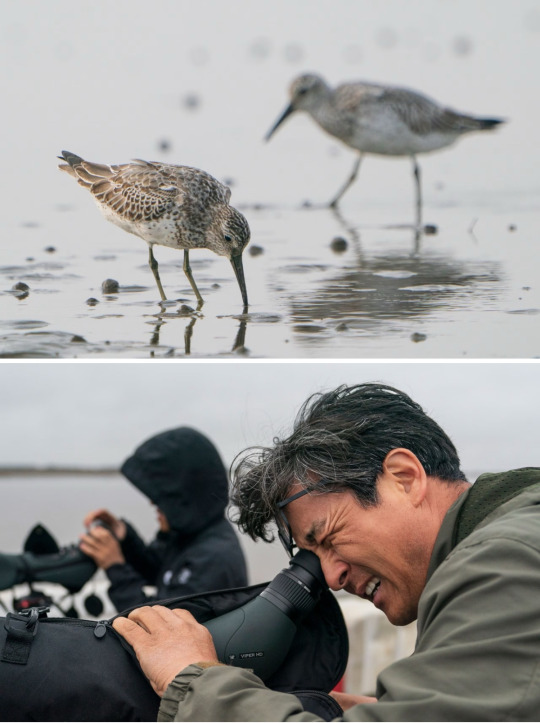
Top: Great knots feed on clams and seaworms at a tidal flat near Yubudo, a small island off the west coast of South Korea. About 80 percent of great knots have disappeared in the last two decades due to habitat loss.
Bottom: Dongpil Oh and his son, Seungjun Oh, conduct monthly surveys of shorebird populations on the the Sura tidal flat found in Gunsan, South Korea. Sura is one of the last remaining tidal flats found within the Saemangeum reclamation site. Dongpil and Seungjun are part of the Saemangeum Citizen Ecology Investigation Team, a grassroots organization that advocates for conservation and documents threats to tidal flats impacted by the Saemanguem.
It wasn’t only wildlife that suffered. Before the wall, the area was known for the nation’s best clams, with a fishing industry supporting around 20,000 people. Nearly all of that disappeared.
And yet despite promises of jobs made to the community, developers have completed less than half of the reclamation, and much of what has been reclaimed are undeveloped empty lots.
Saemangeum developers now plan to build an airport over the last remaining tidal flat, Sura, with construction scheduled to begin in 2024. Activists are suing to stop it, pointing out that the site still provides habitat for endangered species like black-faced spoonbills and Far Eastern curlews.
“It’s painful to remember how much it’s changed. Sometimes you forget how beautiful it was in the past because your eyes adjust to what it looks like now,” said Dongpil Oh, one of the activists involved and leader of the Saemangeum Citizen Ecological Investigation Team.

Left: Halophytes turn red on a tidal flat in Sinan, South Korea. South Korean researchers are studying how salt-tolerant plants like these can boost tidal flats’ ability to fight climate change by absorbing carbon.
Right: A blue-spotted mudskipper jumps during a mating dance at low tide in Sinan. Resting in its burrow at high tide and feeding in the mud when the tide goes out, the unusual, amphibious fish is adapted to the tidal flat’s drastic daily changes.
Bottom: The sun sets over Suncheon Bay Wetland Reserve at low tide. About 16 percent of the world's tidal flats have been destroyed in just the past few decades, but science is increasingly showing how important these ecosystems are for preserving wildlife and fighting climate change.


Top: National Institute of Ecology researchers and local volunteers tag baby black-faced spoonbills with GPS trackers in Incheon, South Korea. Around 90 percent of these endangered shorebirds breed on the country’s west coast. After their worldwide population dropped below 300 in the late 1980s, conservation efforts have brought their numbers to around 5,200. “As a top predator in tidal flats, their health can indicate the health of the overall ecosystem,” researcher Inki Kwon said.
Bottom: Ecotourist guide Sunjeong Heo points out a flock of birds over a tidal flat at Suncheon Bay Wetland Reserve in South Korea. Drawing over six million visitors a year, the UNESCO World Heritage site is a blueprint for the country’s tidal flat conservation and ecotourism.
A New Era of Conservation
After 30 years of construction, Saemangeum has become synonymous with ecological collapse, but it also sparked an environmental movement in South Korea after people witnessed what happens when tidal flats are lost.
Two years after the Saemangeum seawall was finished, in 2008, the South Korean government banned new large-scale reclamation projects—though developments already in progress, like Saemangeum, are still permitted.
And in 2019, reclamation of tidal flats finally plateaued in South Korea, when the net gain from restoration barely surpassed the loss, according to a 2023 report from the International Union for Conservation of Nature.
One of the best places to see the benefit of this kind of conservation is South Korea’s Suncheon Bay Wetland Reserve, on the peninsula's southern edge. The wetland was spared from the threat of development in the ‘90s, when residents and activists protested the government’s plan to mine the land.
Suncheon Bay became the country’s first internationally protected coastal wetland, and its tidal flats were designated a UNESCO World Heritage site in 2021, along with four other tidal flats in South Korea. Every year, over six million tourists visit the wetland and the nearby National Garden to see wildlife like hooded cranes and blue-spotted mud skippers.
With municipal and national funds, the Suncheon Bay Wetland Reserve bought nearby farmland by the coast, restoring the connection with the sea.
Their holistic approach to restoration has introduced organic rice farming to reduce pollution from runoff and educational opportunities for ecotourists, residents, and children in local schools. Suncheon’s success is a blueprint for tidal flat conservation around the world.
“Our focus is on letting the tide flow again, like it always did,” said Sunmi Hwang, a conservationist with the wetland reserve. “And then nature heals itself.”
#Environment#South Korea 🇰🇷#Ecological Disaster#Tidal Flats#Shoreline#South Korean Scientists#Ecosystem#Anna Jeanine Kim#National Geographic#Wildlife Habitat
3 notes
·
View notes
Text
Holidays 4.15
Holidays
Anime Day
Anniversary of Tarija (Bolivia)
AR-15 Day
Ariadne Asteroid Day
ASL Day (American Sign Language Day)
Banyan Tree Day (Lahaina, Maui, Hawaii)
Bija Mangala (Field Cultivation Festival)
Buck Rogers Day
Children’s Day (Spain)
Criminal Investigation Department Employees Day (Ukraine)
Da Vinci Day
Day of Love (Georgia)
Day of People (Aysellant)
Day of Radio-Electronic Fight Troops (Russia)
Day of the Sun (North Korea)
Father Damien Day (Hawaii)
Fluff Appreciation Day
415 Day
Freak Out Day
Gallaudet Day
Good Roads Day (Illinois)
Great Stichwort
Hardware Freedom Day
Hillsborough Disaster Memorial Day (Liverpool, UK)
Himachal Day (India)
Historical City Day (Malacca)
Hug Your Boiler Day
Income Tax Pay Day
International Biomedical Laboratory Science Day
International Pompe Day
Ivory Soap Day
Jackie Robinson Day
Kim Il Sung Day (North Korea)
Lilac Day (French Republic)
Lover’s Day (Kazakhstan)
Mariah Carey Day (California)
Melaka UNESCO Heritage Day (Malaysia)
Microvolunteering Day
National Anime Day
National ASL Day
National Collegiate Recovery Day
National Griper’s Day
National Hookup Day
National Keaton Day
National Laundry Day
National Poet Day (Peru)
National Rubber Eraser Day
National Security Education Day (Hong Kong)
National That Sucks Day
National Titanic Remembrance Day
One Boston Day
Purple Up Day
Quantum Teleportation Day
Rubber Eraser Day
Swallow Day (UK)
Take a Wild Guess Day
Tax Day (US)
Tax Resistor's Day
That Sucks Day
Tipsa Diena (Traditional start of plowing; Ancient Latvia)
Titanic Remembrance Day
Type 1 Diabetes Day
Universal Day of Culture
World Art Day
World Tiny Art Gallery Day
Food & Drink Celebrations
Fast Food Day
McDonald’s Day
National Glazed Spiral Ham Day
National Takeout Day (Canada)
3rd Monday in April
Boston Marathon Day [3rd Monday]
National Stress Awareness Day [3rd Monday]
Landing of the 33 Patriots Day observed (Uruguay) [3rd Monday]
Patriots' Day (Maine, Massachusetts, Wisconsin) [3rd Monday]
Sechseläuten ends (Six Ringing Festival; Zurich, Switzerland) [3rd Monday]
Weekly Holidays beginning April 15 (3rd Week)
National Work Zone Safety Awareness Week [thru 4.19]
Undergraduate Research Week [thru 4.19]
Week of the Young Child [thru 4.19]
Independence & Related Days
Independence Day Holiday (Israel)
Unitedlands (Declared; 2022) [unrecognized]
Vishwamitra (f.k.a. Children’s Group; Declared; 2007) [unrecognized]
New Year’s Days
Day after Sidereal New Year (South and Southeast Asian) (a.k.a. …
Bengali New Year (India)
Bohag Bihu (Parts of India)
Himachl Day (Parts of India)
Lao New Yar (Laos)
Masadi (Parts of India)
Nababarsha (Parts of India)
New Year Holidays (Myanmar)
Sarhul (Parts of India)
Songkran (Thailand)
Water-Sprinkling Festival continues (Yunnan, China)
Poila Boishakh (Bengali New Year)
Festivals Beginning April 15, 2024
Boston Marathon (Boston, Massachusetts) [3rd Monday]
Coquina Beach Seafood & Music Festival (Coquina Beach, Florida) [thru 4.17]
Singing in the Sun (Myrtle Beach, South Carolina) [thru 4.20]
TED Conference (Vancouver, British Columbia, Canada) [thru 4.19]
Feast Days
Abbo II of Metz (Christian; Saint)
Arshile Gorky (Artology)
Bananas with Everything Day (a.k.a. Banana Day; Pastafarian)
Basilissa and Anastasia (Christian; Martyrs)
Day of Tellus Mater (Pagan)
Elizabeth Catlett Mora (Artology)
Father Damien (The Episcopal Church)
Festival of Hero/Bast (Ancient Egypt)
Festival of Matsu/Mazu (Goddess of the Sea; Taoism)
Fordicidia (Old Roman Festival of Fertility to honor Ceres)
Henry James (Writerism)
Hippachus (Positivist; Saint)
Hunna (Christian; Saint)
Jeffrey Archer (Writerism)
Kanamara Matsuri (Iron Phallus Festival; Japan)
Leonardo da Vinci (Artology)
Munde (Christian; Saint)
Padarn (Christian; Saint)
Pammy (Muppetism)
Paternus of Avranches (Christian; Saint)
Peter Gonzales (Christian; Saint)
Ruadan of Lothra (Christian; Saint)
Rusalja (Celebration of River Spirts Rusalki of the Lemko People of Carpathia; Starza Pagan Book of Days)
Tellus Mater (Old Roman Mother Earth Festival)
Vlad Tepes Day (Church of the SubGenius; Saint)
Lucky & Unlucky Days
Fortunate Day (Pagan) [14 of 53]
Sakimake (先負 Japan) [Bad luck in the morning, good luck in the afternoon.]
Uncyclopedia Bad to Be Born Today (because the Titanic Sank and it’s also Tax Day.)
Premieres
The Adventures off Marco Polo (Film; 1938)
Aftermath, by The Rolling Stones (Album; 1966)
The Art of Real Happiness, by Norman Vincent Peale (Book; 1950)
The Black Island, by Hergé (Graphic Novel; 1938) [Tintin #7]
Catalogue d’Oiseaux, by Olivier Messiaen (Pieno Pieces; 1959)
Colors (Film; 1988)
Dark Command (Film; 1940)
Donald’s Nephews (Disney Cartoon; 1938)
Don’t Speak, by No Doubt (Song; 1996)
84, Charing Cross Road, by Helene Hanff (Novel; 1970)
El Amor Bruno (Love, the Magician), by Manuel de Falla (Ballet; 1915)
Fantastic Beasts: The Secrets of Dumbledore (Film; 2022)
Fargo (TV Series; 2014)
The Fitzgeralds and The Kennedys, by Doris Kearns Goodwin (Book; 1987)
Flashdance (Film; 1983)
Flowers for Algernon, by Daniel Keyes (Short Story; 1959)
Genghis Khan (Film; 1965)
Girls (TV Series; 2012)
The Hypo-Chondri-Cat (WB MM Cartoon; 1950)
The Little Goldfish (MGM Cartoon; 1939)
Little Red School Mouse (Noveltoons; 1949)
In Living Color (TV Series; 1990)
The Last Emperor (Film; 1988)
The Lumberjack (Oswald the Lucky Rabbit; 1929)
The Moon and Sixpence, by W. Somerset Maugham (Novel; 1919)
Mouse Come Home (Andy Panda Cartoon; 1946)
Outer Banks (TV Series; 2020)
Outer Range (TV Series; 2022)
Rattus Norvegicus, by The Stranglers (Album; 1977)
Ride ‘Em Plowboy (Oswald the Luck Rabbit Disney Cartoon; 1928)
Rio (Animated Film; 2011)
Robinson Crusoe’s Broadcast (Terrytoons Cartoon; 1938)
Rock & Rule (Animated Film; 1983)
Rock for Light, by The Bad Brains (Album; 1983)
Stage Fright (Film; 1950)
St. Matthew’s Passion, by Johann Sebastian Bach (Oratorio; 1729)
Think, recorded by Aretha Franklin (Song; 1968)
To the Finland Station, by Edmund Wilson (Novel; 1940)
The Twenty-One Balloons, by William Pène du Bois (Novel; 1947)
Whole Lotta Shakin’ Goin’ On, by Jerry Lee Lewis (Song; 1957)
Wild, by Cheryl Strayed (Memoir; 2012)
Today’s Name Days
Anastasia, Damian, Una (Austria)
Rastislav, Teodor (Croatia)
Anastázie (Czech Republic)
Olympia (Denmark)
Uljas, Uljo, Verner, Verni (Estonia)
Linda, Tuomi (Finland)
César, Paterne (France)
Anastasia, Damian, Una (Germany)
Leonidas (Greece)
Anasztázia, Tas (Hungary)
Anastasio, Annibale (Italy)
Aelita, Agita, Balvis, Gastons (Latvia)
Anastazijus, Liudvina, Modestas, Vaidotė, Vilnius (Lithuania)
Oda, Odd, Odin (Norway)
Anastazja, Bazyli, Leonid, Ludwina, Modest, Olimpia, Tytus, Wacław, Wacława, Wiktoryn, Wszegniew (Poland)
Aristarh, Pud, Trofim (Romania)
Fedor (Slovakia)
Telmo (Spain)
Oliver, Olivia (Sweden)
Mstyslav, Mstyslava (Ukraine)
Kenya, Octavia, Tavia, Tucker (USA)
Today is Also…
Day of Year: Day 106 of 2024; 260 days remaining in the year
ISO: Day 1 of week 16 of 2024
Celtic Tree Calendar: Saille (Willow) [Day 2 of 28]
Chinese: Month 3 (Wu-Chen), Day 7 (Ji-You)
Chinese Year of the: Dragon 4722 (until January 29, 2025) [Wu-Chen]
Hebrew: 7 Nisan 5784
Islamic: 66 Shawwal 1445
J Cal: 16 Cyan; Twosday [16 of 30]
Julian: 2 April 2024
Moon: 50%: 1st Quarter
Positivist: 22 Archimedes (4th Month) [Varro]
Runic Half Month: Man (Human Being) [Day 6 of 15]
Season: Spring (Day 28 of 92)
Week: 3rd Week of April
Zodiac: Aries (Day 26 of 31)
2 notes
·
View notes
Text


湛江市, 广东省, 中國 | Zhanjiang City, Guangdong Province, China (2) by Pillar1984
Via Flickr:
(1) Sugarcane & peanut field, South Subtropical Crops Research Institute.
(2) Sea of pineapples in XuWen. China's largest pineapple base.
2 notes
·
View notes